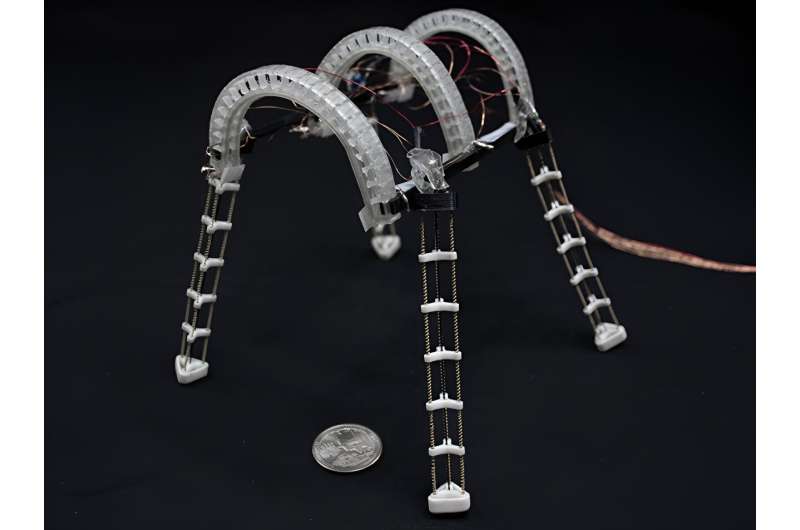This article has been reviewed according to Science X's editorial process and policies. Editors have highlighted the following attributes while ensuring the content's credibility:
fact-checked
peer-reviewed publication
trusted source
proofread
Morphing robots can grip, climb and crawl like insects

Pulling inspiration from the natural world, researchers at Colorado State University have developed a trio of robots that can morph their bodies and legs as needed to better crawl, shimmy or swim over difficult terrain.
These new robotic systems are designed to mimic the way biological organisms adapt their shape depending on their life cycle or environment and were developed by a team from the Department of Mechanical Engineering. The work is described in a new paper published in Nature Communications, which outlines the three robotic types and their different abilities including gripping, climbing and amphibious travel
Associate Professor Jianguo Zhao led the research team on campus in the Department of Mechanical Engineering with recent Ph.D. graduate Jiefeng Sun serving as lead author for the paper. Zhao said these robots are made of materials that can become soft or rigid with changes in temperature and are able to move without the need for bulky power systems such as magnetic coils. That makes them more versatile and better equipped to potentially help humans search tight disaster areas for survivors in the future.
"Our embedded morphing scheme uses a lightweight artificial muscle similar to a human muscle, and it contracts when electricity is applied," he said. "By embedding these artificial muscles in the spine of the robot or in its skin, we can achieve a variety of shape-types. Altogether, this approach offers a promising path towards developing robots that can navigate and work in difficult environments."
The paper outlines three different morphing robotic schemes. The first design is a gripper which can sense and adjust its shape to grasp on to items better. Another is a quadrupedal robot that can flatten itself to crawl through openings or grip a ledge to mauver across gaps. The final robot is untethered and can change its leg shape and position to effortlessly switch from walking on land to swimming in water. All of three of these systems can morph on demand and the process can be reversed if needed, said Zhao.
"Frogs can make these kinds of changes effortlessly for example. They start as tadpoles with tails for swimming before developing legs that let them jump, crawl or swim," he said. "We take inspiration from those transformations, but achieving animal-like embedded shape morphing in robots remains challenging and is something we hope this work will continue to address."
Next steps for the robotic systems
The team has been working on this research since 2017, initially struggling to find a good method for actuation—or making the arms and legs contract and move. The current approach using artificial muscles driven by electricity allows for the needed mechanical systems to be contained inside the robot.
"Our system can also sense the different shapes or bending angles that are occurring based on the change of electrical resistance for the artificial muscle we are using," he said. "This is a unique capability for our system and allows for adjustable, versatile and precise shapes depending on the current position in the robot."
The team will now begin to refine the systems and explore ways to make these robots more independent in their activity. Right now, the systems are remote controlled, but Zhao envisions a time when they will be able to operate on their own—deciding which shape or morphology would be best.
"We are considering ways to add sensors or cameras that could help the robot autonomously navigate and decide for itself the best morphology and then apply and use that morphology for energy efficient locomotion," Zhao said.
More information: Jiefeng Sun et al, Embedded shape morphing for morphologically adaptive robots, Nature Communications (2023). DOI: 10.1038/s41467-023-41708-6

















